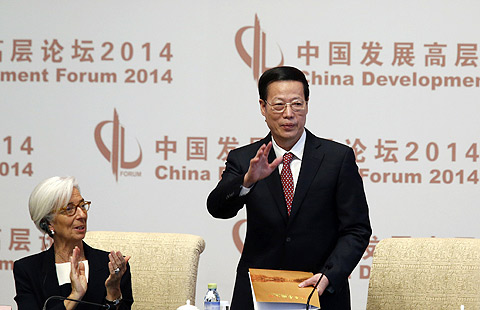Channeling prosperity
Updated: 2014-04-03 08:21
By Zhao Ruixue (China Daily)
|
|||||||||||
The Beijing-Hangzhou Grand Canal's flow seems to follow the direction of fortune - especially since its ancient glory is being reconstructed after being destroyed in World War II and 85 sites along the canal have jointly applied for UNESCO World Heritage status.
The artificial waterway that linked northern and southern China served as a lifeline for dynasties for 14 centuries. It carried materials and ideas between the political capitals of the north and economic heartland of the south.
The canal produced 70 percent of the country's economic output during the Ming (1368-1644) and Qing (1644-1911) dynasties, says Chen Wei, Party chief of Shandong's Zaozhuang city along the canal.
Over time, the canal's value to the 18 cities that border it has shifted from logistics to culture and tourism.
The channel can be thought of as a necklace, sparkling with the 85 sites applying for World Heritage status.
Zaozhuang, the first city the Grand Canal meets when it enters Shandong province from the south, has the only stretch unchanged since the Ming Dynasty.
"Most docks and mooring points along the canal have been changed or renovated by modern development, but Zaozhuang has a 3-kilometer passage along which the docks and mooring points are original," Chen says.
The width is also unchanged, he says.
On paper, the Grand Canal runs 1,747 kilometers - making it nine times longer than the Suez Canal. Parts date back to the 5th century BC.
The original canal system took shape during the Sui Dynasty (AD 581-618), the capital of which was Luoyang - now the second largest city in Henan province by GDP.
Sui emperor Yang Guang needed to transport grain from the fertile Yangtze region northward to support his court and armies. So the emperor forced a huge number of workers to build the canal to connect Luoyang with Beijing and Hangzhou, capital of today's Zhejiang province.
The Grand Canal didn't pass through Zaozhuang until the Ming Dynasty, when an east-west waterway called the Jia Canal was devised to circumnavigate the Yellow River's floods, which frequently paralyzed the Grand Canal.
"The Jia Canal is built according to its geographic features. Since it was completed, the Grand Canal has rarely been obstructed by the Yellow River, solving the biggest problem for emperors," Zaozhuang's Grand Canal culture promotion office expert Dong Yunqi says.
The canal has developed Zaozhuang's historical coal business, which is waning as deposits shrink.
In 1878, Chung Hsing Coal Mining Co, now Zaozhuang Coal Mining, was founded in the area. The company ran 14 mines across Zaozhuang then, placing the city among China's top three coal bases until the 1930s.
"Before 1912, the Grand Canal served as the only way for the company to transport coal southward," Zaozhuang Mining Co Ltd publicity office director Hu Lebao says.
It also shipped construction materials purchased from Germany, he says.
The Jia Canal was expanded after New China's 1949 founding to serve increasing demand for cargo transportation. It's currently 99 km long.
Zaozhuang has four ports along the canal. Their throughput reached 32.15 million tons last year.
"The Grand Canal makes inland Zaozhuang a port city," Chen says.
"It plays an important role in shipping cargo like coal, cement and wood materials."
The city's port transportation management office deputy head Li Ying says: "Compared with land transport, the canal saves energy and generates less pollution."
Per ton transported every km, the CO2 generated by canal-based transportation is two-thirds of that transported by railway and one-fifth of that transported by road.
The canal has also given rise to an area of wetlands since it changed the water system. One swath, the Weishanhu wetlands, contains a combined water area of 1,200 square km.
The Grand Canal also aids the South-to-North Water Diversion Project by transporting clean water from the Yangtze River to the northern cities, reincarnating its standing as a lifeline.
zhaoruixue@chinadaily.com.cn
|
The Zaozhuang section of the Grand Canal has remained unchanged since the Ming Dynasty. |
(China Daily 04/03/2014 page18)
Today's Top News
Turkey expects China's high speed rail investment
NASA halts co-op with Russia
Putin officially divorces his wife
Search for MH370 'must not ease up'
China announces economic package
2 more human H7N9 cases in China
Full text of China's policy paper on EU
Xi's trip builds bridge to Europe
Hot Topics
Lunar probe , China growth forecasts, Emission rules get tougher, China seen through 'colored lens', International board,
Editor's Picks

|

|

|

|

|

|






